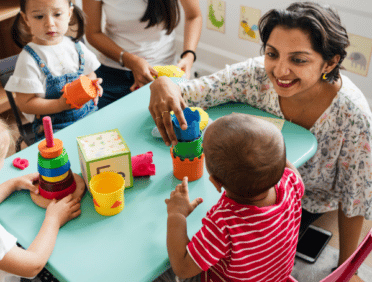Filter by
Safeguarding in School: Creating a Safe Educational Environment
One of the most important responsibilities that schools in the United Kingdom have is to safeguard its children, looking out for their health and safety. It is necessary to implement a variety of policies, procedures, and practices in order to establish a secure atmosphere for educational purposes. In order for students to be able to flourish intellectually and socially, it is crucial that they have access to effective safeguarding measures that ensure their physical and mental safety.
A comprehensive approach that needs the commitment and collaboration of the entire school community is required for the purpose of safeguarding in schools in the United Kingdom. Schools are able to guarantee that every student has the chance to study and develop in a safe environment by adhering to legal frameworks, implementing effective policies, and cultivating a climate that is both safe and supportive.
The protection of children is of the utmost importance, and the implementation of safeguarding methods is essential to the accomplishment of this objective.
Legal Framework and Guidelines
The Children Act 1989 and 2004
The Children Act of 1989 and its subsequent update in 2004 serve as the cornerstone of the safeguarding system in schools in the United Kingdom. The purpose of these acts is to establish the legal obligations that schools have to safeguard the well-being of children and promote their welfare. In order for schools to fulfil these standards, they need to ensure that they have policies and processes in place.
Keeping Children Safe in Education (KCSIE)
Annually, the Department of Education revises “Keeping Children Safe in Education” statutory guidelines. This document explains the obligations that schools and institutions are responsible for. It is required that all members of the staff receive consistent training in order to recognise and respond appropriately to indications of abuse and neglect.
At each and every school, the Designated Safeguarding Lead (DSL) is expected to fulfil a full set of responsibilities, which are outlined in the guidance.
Roles and Responsibilities
Designated Safeguarding Lead (DSL)
It is mandatory for every school to appoint a DSL who will be accountable for monitoring the safeguarding procedures that are in place. The Department of Social Services (DSL) is required to possess the knowledge and training necessary to manage safeguarding issues, offer support to staff members, and communicate with external organisations such as social services.
School Staff
Students are the responsibility of every member of the school staff, including teachers, administrative staff, and support staff. To accomplish this, it is necessary to remain watchful, to report any concerns, and to be familiar with the safeguarding procedures for the institution. Providing employees with consistent training ensures that they are able to identify the indicators of abuse, neglect, or exploitation.
Governing Bodies
The effectiveness of the implementation of safeguarding measures is largely dependent on the governing bodies and trustees of the school. In addition to providing assistance for the DSL and ensuring that the school environment is safe for all students, they are required to conduct frequent reviews of safeguarding measures.
Safeguarding Policies and Procedures
Child Protection Policies
The policies that schools put in place to protect children must be thorough, and they must be routinely updated and conveyed to all of the staff members, parents, and students. All occurrences are treated in a timely and suitable manner as a result of these policies, which explain the procedures for reporting and managing issues.
Safer Recruitment
School districts are required to implement more secure recruitment procedures in order to prevent inappropriate individuals from working with children. This entails doing exhaustive background checks, acquiring references, and making certain that all employees possess the relevant credentials and clearances, such as the Disclosure and Barring Service (DBS) check.
Online Safety
One of the most important aspects of protection in this day and age is ensuring proper internet safety. Educating children about the dangers that are linked with the internet and social media, as well as taking precautions to safeguard them from dangers that can be found online, is a responsibility that schools have. This includes keeping an eye on what students are doing online and providing them with resources to help them be safe once they are online.
Reporting and Responding to Concerns
Identifying Signs of Abuse
Abuse can take many forms, including physical, emotional, and sexual abuse, as well as neglect, and staff members need to be taught to recognise all sorts of abuse. For early intervention to be successful, it is essential to have a thorough understanding of the indications, which may include unexplained injuries, signs of fear, or changes in behaviour.
Reporting Mechanisms
Mechanisms for reporting that are easy to understand are necessary for effective safeguarding. There must be mechanisms in place at schools that allow both teachers and kids to report issues in a confidential manner. In most cases, the DSL serves as the initial point of contact; however, colleges and universities may also offer anonymous reporting methods.
Interagency Collaboration
Working together with outside organisations is frequently necessary for effective protection. For the purpose of ensuring a coordinated response to safeguarding issues, schools are required to collaborate closely with local authorities, health services, and law enforcement. Through the efforts of this alliance, children are guaranteed to receive the necessary support and protection.
Creating a Safe School Environment
Physical Safety
The maintenance of a secure school environment, the execution of routine safety drills, and the establishment of health and safety regulations are all vital components in the process of ensuring the kids’ physical safety. These include precautions such as the installation of safe entry systems, the provision of supervision during school hours, and the performance of safety inspections on school equipment and facilities.
Emotional Well-being
Making sure that pupils are able to maintain their mental health is an essential component of keeping them safe. It is important for schools to make counselling services available to students, raise awareness about mental health issues, and cultivate an inclusive atmosphere in which students feel comfortable voicing their difficulties.
Anti-Bullying Strategies
When it comes to a child’s health and wellbeing, bullying can have severe repercussions. Schools have a responsibility to implement comprehensive anti-bullying methods, which should include specific policies, assistance for victims, and educational programmes that encourage students to respect and empathise with one another.
Frequently Asked Questions (FAQs)
When we talk about safeguarding in schools, we are referring to the policies and procedures that are put in place to protect children from being harmed, abused, or neglected. The fact that it guarantees a safe and secure atmosphere in which children may learn and develop without the worry of being exploited or mistreated is the reason why it is very important.
The term “safeguarding” refers to the protection of children, the promotion of children’s wellbeing, and the establishment of an environment that provides safety from harm.
Assuring that children’s physical and mental health needs are fulfilled, providing an inclusive atmosphere that respects the dignity and rights of every child, and educating pupils on how to protect themselves from harm are all aspects of safeguarding that are included in the process of preventing children from being abused or neglected.
Schools are typically in a unique position to recognise and respond to concerns early on, and they work alongside families and other organisations to provide a comprehensive approach to child welfare. As a result, schools play an important part in the larger system of safeguarding children.
A child-centred approach that takes into consideration what is in the child’s best interests is one of the basic concepts of safeguarding in schools in the United Kingdom. Other essential principles include making sure that the safety and welfare of children is a top priority, acknowledging that every child has the right to be protected from abuse and neglect, and implementing a child-centred approach.
As important as it is to foster an atmosphere in which children can feel safe, heard, and appreciated, it is essential to promote this environment. It is imperative that educational institutions make certain that all staff members receive training and are aware of their obligations regarding the protection of students.
These principles place an emphasis on the significance of early intervention, which is the process of addressing concerns in a timely manner in order to prevent them from becoming more serious. Additionally, these principles emphasise the importance of collaboration with other organisations and professionals in order to provide a coordinated response to security concerns.
The schools are also responsible for ensuring that the voices of children are heard and that their concerns are treated seriously. This is done in order to cultivate an atmosphere of trust and openness in which students feel comfortable disclosing any problems they may have.
Legislation in the United Kingdom, such as the Children Act 1989 and the Education Act 2002, defines safeguarding as the actions taken to promote the wellbeing of children and protect them from harm. Among these are the prevention of the impairment of children’s health and development, the guarantee that children will grow up in conditions that are consistent with the provision of safe and effective care, and the implementation of measures that will enable all children to have the best possible results.
Keeping Children Safe in Education (KCSIE) is a set of guidelines that stipulates that educational institutions and schools must adhere to a number of specified requirements. These responsibilities include the adoption of safeguarding policies, the use of safe recruiting procedures, and the appointment of a Designated Safeguarding Lead (DSL) to oversee the management of safeguarding issues.
The Act gives specific responsibilities that schools are required to accomplish in order to comply with the legislation. It is necessary for schools to work together with other groups, such as social services and the police, in order to ensure that a comprehensive plan for the safety of children is implemented.
The legislative framework allows for the incorporation of safeguarding into the culture of educational institutions, ensuring that it is an essential component of their operations.
There are many tasks and obligations that school staff members are responsible for, such as being watchful and aware of indications of abuse and neglect, reporting any concerns about the wellbeing of a child to the Designated Safeguarding Lead (DSL), and attending safeguarding training sessions on a regular basis.
They are required to adhere to the safeguarding regulations and procedures of the school in order to provide support to children who have been indicated as being in need of assistance or who have been identified as being in danger. The initial point of contact for children who are experiencing distress is typically the teachers and other members of the school staff. This is a widespread practice.
They play an essential part in establishing a trustworthy relationship with children, allowing them to feel comfortable voicing their worries. In addition to reporting and providing immediate intervention, staff members are accountable for the creation of a secure and caring learning environment, the incorporation of safeguarding into the curriculum, and the promotion of resilience and well-being among students.
It is important to provide children with the knowledge and skills necessary to protect themselves from harm, and this includes teaching them about healthy relationships, personal safety, and online safety.
Paying attention to changes in their child’s behaviour, looks, and emotions can help parents and guardians identify the indicators of abuse or neglect that may be occurring in their child. Warning indicators may include injuries or bruises that cannot be explained, rapid changes in behaviour such as being withdrawn or violent, fear of going to school or particular locations, poor cleanliness, or clothing that is not suited for the weather environment.
Alterations in one’s sleep or food habits are another possible symptom of distress. Every parent should make it a priority to keep the lines of communication open with their children and encourage them to talk about the things that happen in their lives on a daily basis as well as any worries that they might have.
While observing the interactions that a child has with both their peers and adults, one might gain more insights into the child’s overall well-being. In addition, it is essential for parents to increase their knowledge of the various types of abuse, including physical, emotional, sexual, and neglect, so that they are better able to recognise the potential warning signs and, when necessary, take the appropriate action.
Parents who are concerned about their children should not be afraid to seek the guidance of professionals, such as teachers, school counsellors, or child protection agencies, if they have any worries.
In the event that a safeguarding concern is brought up, the school should listen to the child and take their worries seriously. Additionally, the school should record the worry in a timely and accurate manner, and it should immediately report the concern to the Designated Safeguarding Lead (DSLS). In order to comply with its safeguarding policy, the school is required to notify social services or the police, among other possible actions.
At every stage of the procedure, it is of the utmost importance to guarantee the child’s safety and well-being. The Department of Social Services will conduct an assessment of the issue, collect additional information if it is required, and then make a decision regarding the subsequent steps, which may include a referral to other agencies for additional investigation and support needs.
The school should maintain records of any issues and actions in a way that is open, thorough, and secure. This will ensure that the child’s privacy is respected and that confidentiality is maintained.
During this phase, it is of the utmost importance to offer the child support and reassurance, ensuring that they comprehend that they have done the right thing by speaking up and that the people who are surrounding them are there to assist and protect them.
At least once a year, the staff at the school should participate in training on safeguarding. In addition, the Designated Safeguarding Lead (DSL) and their deputies should undergo training once every two years in order to maintain a level of familiarity with the most recent policies and procedures.
It is of the utmost importance that all members of the staff receive frequent updates and refreshers in order to ensure that they are aware of any changes that may occur in the procedures of the school or in the legislation that governs the institution. The training that is being provided should include a wide variety of topics, including the ability to identify the signs of abuse and neglect, familiarity with the safeguarding policies and procedures of the school, the ability to report concerns, and the ability to respond appropriately to disclosures made by children.
The training should cover specific subjects such as dealing with radicalization and extremism, as well as dealing with mental health and internet safety. It is necessary to ensure that the staff is well-informed and self-assured in their roles as safeguards for the children in order to produce a secure and encouraging environment for the students. This is because the children are the focus of the staff’s attention.
It is critical that workers have access to opportunities for continuing professional development in order for them to be able to broaden their knowledge and improve their skills in the field of occupational safety and health.
Comprehensive safeguarding policies that are in accordance with the most recent legislation and guidelines from the government, are reviewed and updated on a regular basis, and are made available to all staff members, parents, and students are legally obliged to be in place in schools. The methods for reporting and managing concerns should be included in these rules.
The roles and obligations of all members of the staff, including the DSL, should be laid out in great detail. In addition, concerns such as the safety of the internet, the prevention of bullying, and health and safety should be addressed. The rules need to include a description of safe recruitment practices, which will ensure that all employees and volunteers are subjected to the necessary background checks and adequate training. A description of these processes is required.
The task of ensuring that all members of the school community are aware of and able to comprehend the rules and regulations that have been established for the purpose of protecting pupils falls on the shoulders of the instructional institutions. In order to offer an assessment of the effectiveness of the safeguarding measures and to identify areas that could benefit from improvement, it is recommended that audits and evaluations be carried out on a regular basis.
Schools are required to publish their safeguarding policy on their website and ensure that all staff members, students, and parents are aware of it and know how to access it. Additionally, schools must guarantee that the policy is accessible to families. Maintaining this demand is a requirement that must be met.
The following are some of the ways in which students can report concerns regarding safeguarding:
Speaking directly to a trusted teacher or the Designated Safeguarding Lead (DSL), using any established school reporting mechanisms such as a dedicated phone line or online form, seeking assistance from school counsellors or pastoral care staff, and reaching out to child protection agencies or helplines if they feel at ease reporting within the school.
One of the most important things that educational institutions should be able to do is create an environment in which students are free to voice whatever concerns they may have without worrying about the consequences of doing so. It is vital to offer students information regarding safeguarding, their rights, and the measures to follow in order to seek aid in order to accomplish this goal.
It is of the utmost importance to make certain that the methods of reporting are clear and easily accessible. In addition, the students should be given the assurance that their problems will be handled with care and discretion and that their complaints will be taken seriously.
It is possible to significantly increase the effectiveness of safety precautions by cultivating a culture of openness and trust among the school community.
Schools should establish comprehensive internet filtering and monitoring systems, educate students about safe internet habits and the consequences of engaging in activities online, and incorporate courses on digital literacy and cyberbullying into the curriculum in order to ensure that children are safe when using the internet.
Providing training for staff on how to recognise and respond to online hazards, as well as encouraging parents to participate in their children’s online activities, are examples of additional steps that are extremely important. Schools should design and enforce clear policies surrounding the use of technology and social media, outlining acceptable behaviour and consequences for violations.
These policies should be plain and concise. Schools should cooperate together with law enforcement and other organisations to address significant concerns regarding online safety, and they should provide tools and support for kids who have experienced harassment or exploitation while using the internet.
With the goal of ensuring that students have access to a digital environment that is safe and secure, it is essential to continuously update and review online safety policies and practices. This is necessary in order to keep up with the rapid evolution of technology and the introduction of new threats.
Management and supervision of any safeguarding concerns, provision of guidance and assistance to staff members on safeguarding issues, communication with local authorities and other agencies, and ensuring that the school’s safeguarding policy is adequately executed are all responsibilities that fall under it. ensuring that accurate records of complaints and actions taken are kept.
The Designated Safeguarding Lead (DPL) is responsible for a variety of obligations, including the delivery of regular safeguarding training to staff members as well as the management of such training schedules.
Both the coordination of the school’s efforts to protect young people and the task of ensuring that all members of the staff are aware of their responsibilities fall under the purview of the Department of Student Life (DSL). They are required to maintain a degree of awareness of the most recent reforms in safeguarding legislation and best practices, in addition to ensuring that the policies and procedures of the school are up-to-date according to the most recent standards.
The Department of Social Services (DSL) also acts as a point of contact for children, parents, and other organisations, providing aid and assistance in the process of addressing matters pertaining to the protection of children.
There are a number of critical skills that a DSL must possess, including the ability to communicate effectively, leadership, and a dedication to supporting the wellness of children.
It is possible for schools to involve parents by providing information on the safeguarding policies and procedures of the school, by offering workshops and resources on themes such as online safety and recognising signs of abuse, and by fostering open communication between the school and the parents.
The importance of involving parents in conversations concerning the health and safety of their children, as well as the establishment of a friendly atmosphere in which parents may feel at ease voicing their concerns, cannot be overstated.
One way for schools to ensure that parents’ viewpoints and insights are taken into consideration during the process of developing and implementing safeguarding measures is to ask them to participate in safeguarding committees or working groups.
As a means of keeping parents aware about safeguarding activities and providing chances for input and participation, regular newsletters, meetings, and conferences between teachers and parents can be utilised.
Schools can achieve this goal by cultivating a strong partnership with parents that works together to protect the safety and wellbeing of all students.
The presence of unexplained injuries or frequent accidents, poor physical condition or hygiene, behavioural changes such as aggression or withdrawal, fearful behaviour towards certain individuals, poor school attendance and performance, and inappropriate sexual behaviour or knowledge for their age are all indicators that a child may be facing a potential risk.
Alterations in eating or sleeping patterns that occur suddenly, an excessive amount of secrecy, and a lack of trust in elders are some additional symptoms that may be present. As a result of the fact that certain indications may be symptomatic of other problems, it is essential for adults to take into consideration these signs in the context of the child’s general environment and behaviour.
Consistent observation of the youngster and communication with them can be helpful in elucidating the problem. In situations where there are many symptoms or a consistent pattern of behaviour that is cause for concern, it is imperative that these concerns be reported to the relevant authorities so that further investigation can be conducted.
Through the use of early intervention strategies, it is possible to protect the child from further harm and provide them with the required support.
When it comes to managing claims against staff members, schools should adhere to their safeguarding policy and procedures, report the allegation to the Local Authority Designated Officer (LADO), ensure the safety and welfare of the child concerned, and undertake an investigation that is both comprehensive and impartial.
While keeping confidentiality and addressing the matter with compassion, it is essential to provide support to the staff member who is participating in the inquiry process. In the course of the investigation, the school is obligated to make certain that the child’s requirements and well-being are given the utmost importance.
There is the possibility of appointing an independent investigator in order to guarantee objectivity and fairness. Maintaining open and honest communication with all of the organisations that are involved and keeping them up to date on the procedure and the findings is something that the institution ought to do. In the event that the allegations are found to be genuine, it is of the utmost importance that the required actions be taken in compliance with the employment laws and the safeguards in place.
Throughout the entirety of the procedure, it is critically crucial to respect the concepts of natural justice and due process for the staff member while simultaneously ensuring that the safety of the child continues to be the first concern.
When we talk about safeguarding, we are referring to a more comprehensive idea that incorporates all of the measures that are taken to protect children from danger and to promote their well-being. Individual children who have been identified as suffering or are likely to suffer considerable harm are the subject of child protection, which is a component of safeguarding that is specifically geared towards child protection.
Protection of children requires responding to situations in which harm has occurred or is likely to occur, in contrast to safeguarding, which includes prevention and early intervention. When we talk about safeguarding, we’re talking about a wide range of activities, such as anti-bullying tactics, health and safety policies, and cyber safety education.
Creating a secure and encouraging atmosphere for all children is the goal of this initiative. On the other hand, child protection refers to the particular steps that are taken to protect children who are at risk of being abused or neglected.
These efforts include cooperating with law enforcement and obtaining referrals to social services. In order to guarantee that every child is shielded from harm and that their well-being is fostered, a complete approach to child welfare must include both safeguarding and child protection as key components.
Providing a safe and supportive environment, providing counselling and mental health services, developing an individualised support plan for the student, collaborating with outside organisations to provide additional resources and assistance, and ensuring that staff members are trained to respond sensitively to the needs of abused children are all ways in which schools can provide support for students.
Providing children with the chance to express their feelings and experiences in a safe setting is one of the most important things that schools can do to ensure that children feel heard and appreciated. When it comes to assessing the student’s development and changing their support as necessary, it may be good to interact with the student on a consistent basis.
Schools should also interact closely with the family of the child, when it is appropriate to do so, in order to provide a coordinated approach to support. This is necessary in order to provide. It is also feasible to aid students in recovering from the trauma of abuse by developing a school culture that is supportive and accepting and that supports resilience and well-being. This is another way that it is possible to assist children in recovering from it.
Offering the student the opportunity to participate in extracurricular activities, peer support groups, and mentoring programmes can be of additional assistance in the process of healing and reintegrating them into the school community.
Recent revisions to the guidance for Keeping Children Safe in Education (KCSIE) put greater emphasis on mental health assistance, internet safety, and the role of the Designated Safeguarding Lead. These amendments are part of the recent updates to safeguarding legislation in the United Kingdom.
The implementation of these modifications into the policies and procedures of educational institutions is obligatory in order to guarantee comprehensive protection for pupils. The Children Act of 1989 and the Education Act of 2002 have been revised in order to incorporate the newly established goals for child protection and to address the emergence of new problems, such as the radicalization and exploitation of children.
Educational institutions are required to acknowledge the necessity of preventing individuals from becoming involved in terrorist activities in order to comply with the Prevent Duty, which is a provision of the Counter-Terrorism and Security Act of 2015. It is mandatory for educational institutions to comply with the General Data Protection Regulation (GDPR) when it comes to the management of sensitive information that is related to the protection of students.
It is essential for schools to keep updated about changes in legislation and to continually assess their policies and processes surrounding child protection in order to ensure that they continue to comply with safety regulations and provide the highest possible levels of protection for each and every child.
A culture of respect and inclusiveness, the implementation of anti-bullying policies and programmes, and the encouragement of student participation in the construction of a positive school climate are all important aspects of the school’s efforts to foster a positive environment.
Also, schools can establish an environment that is safe and welcoming for all kids by providing training for teachers on diversity, equity, and inclusion, as well as ensuring that all students have access to support resources.
These are all ways that schools can go about creating such an environment. The recognition and promotion of diversity in schools, as well as the provision of opportunities for students to gain knowledge about a wide range of cultures and points of view, are all extremely important.
It is possible to support children in the development of skills such as empathy, resilience, and the ability to manage disputes by providing them with a curriculum that combines social-emotional learning. Additionally, schools should make certain that all students are informed of their rights and responsibilities, as well as establish expectations and sanctions for acceptable behaviour.
This should encompass both positive and negative consequences. Creating physical surroundings that are welcoming and accessible to all students, including those with disabilities, is another essential component. These spaces should prioritise accessibility. By routinely collecting feedback from students, parents, and staff, schools have the opportunity to enhance the efficacy of their efforts to foster an environment that is welcoming to all individuals.
Because of this, schools may be able to identify areas in which they can make improvements. The formation of connections with community organisations and the acquisition of expertise from outside sources are two ways in which the school may further increase its capacity to provide a safe and supportive environment for all of its students.
An effective safeguarding policy should include clear definitions of abuse and neglect, procedures for reporting and responding to concerns, roles and responsibilities of staff, including the Designated Safeguarding Lead (DSL), guidelines for safe recruitment and selection of staff, and strategies for promoting a safe environment, including online safety.
All of these elements should be included in the policy. A crucial component is the implementation of protocols for dealing with allegations made against staff members, as well as regular training and updates for staff members.
The policy ought to provide an overview of the school’s dedication to safeguarding, which should also include a declaration of the school’s values and principles in relation to the protection of children. Not only should it include extensive instruction on how to recognise indicators of abuse and neglect, but it should also provide procedures to take in the event that a concern emerges.
Information on how to support children who have been victims of abuse should be included in the policy, as well as information on how to communicate with organisations from the outside world, in order to ensure that a coordinated response is presented. It is of the utmost importance to guarantee that the policy is not only freely available but also routinely reviewed and updated. Ensuring that the policy is easily accessible does not end there.
The building of strong partnerships with local authorities, social services, and law enforcement. It is important for educational institutions to actively seek participation in multi-agency safeguarding discussions and networks. The management of human resources should also emphasise the need to encourage the sharing of information and best practices.
Collaboration between schools and other organisations can take many forms, including the coordination of efforts to support students who are at risk, access to training and resources from external organisations to increase safeguarding practices, and the coordination of efforts to support students who are at risk.
The school also has the opportunity to improve its capacity to address issues regarding the safety of children by ensuring that it maintains constant communication and cooperation with health providers, mental health professionals, and community organisations. This would allow the school to better address concerns regarding the safety of children.
To be able to successfully collaborate with organisations from the outside world, educational institutions must first have well-established protocols in place. This is a crucial requirement.
Not only should these protocols include information sharing agreements and procedures for collaborative assessments and interventions, but they should also include the aforementioned components. As a response that is both more complete and more effective in addressing concerns regarding the safety of children, the establishment of a network of support surrounding the kid, which incorporates the participation of specialists from a variety of fields, has the potential to serve as a viable option.
Educators should make it a priority to stay current on safety efforts at both the local and national levels, in addition to participating in ongoing professional development at their respective institutions. With this, they will be able to stay abreast of the most recent advancements in child safety, including the techniques that have proven to be the most successful and the trends that are continuing to emerge.














